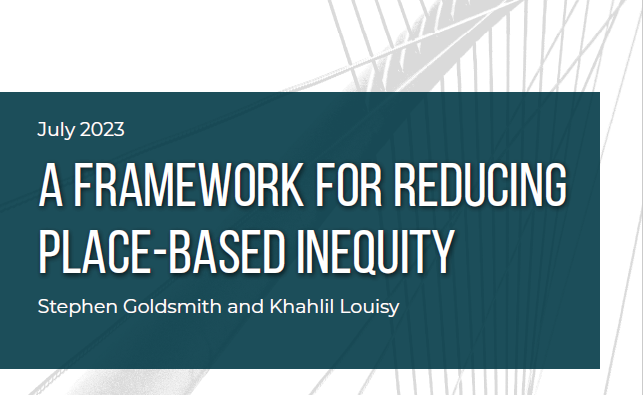- November 18, 2019
- Data Visualization
For many US cities, creating jobs in high-tech sectors is a significant priority because they attract high-skill workers and high salaries. Look no further than the 200-city competition for Amazon’s HQ2 to see just how excited many cities are to attract this workforce. The logic behind city leaders’ attempts to pull in these jobs largely stems from ideas like those in Enrico Moretti’s The New Geography of Jobs; this body of research claims that for every job created in the high-tech sectors, there are five new jobs created in other industries like education, healthcare, transportation, and services, and the increased demand for these workers results in higher wages and standards of living for all of them.
Unfortunately, while the creation of high-tech jobs can result in job creation and higher salaries in other industries, other forces like increased housing costs not only offset the benefits of increased wages, but actually lower people’s disposable incomes. As I discussed in a recent piece on spatial mismatch in US cities, this has forced people in low-wage industries to move further and further away from available jobs in search of more affordable places to live. A new body of research by Neil Lee of the London School of Economics and Stephen Clarke of the Resolution Foundation in London demonstrates not only how damaging high-tech job growth and development is to low-skill workers, but actually how the ratio of tech jobs to low-wage jobs is actually less than one-to-one, never mind one-to-five.
Growing Demand for Inclusive Growth in Cities
If anything is clear from this research, growth in high-skill industries in cities has done more to worsen economic inequality than improve it. However, as the Fourth Industrial Revolution takes off, the growth of jobs in these industries is inevitable, and cities must do more to understand and proactively address the negative impacts of this job growth.
To prevent from further exacerbating economic inequality, researchers, economists, nonprofits and other governmental bodies are calling for cities to prioritize “inclusive growth” in their economic development efforts. In fact, the UNDP’s Sustainable Development Goal #11 calls for “inclusive, safe, resilient and sustainable cities.” Inclusive growth is a term used to describe the concept of ensuring that everyone, regardless of their background, can contribute to and benefit from economic growth.
To try and gauge which cities have been able to achieve inclusive growth in the US, researchers at the Urban Institute studied environmental factors like segregation, housing affordability, educational attainment, and job quality of 41 cities whose economic conditions improved from 1980 to 2013. Of those, 18 cities were less inclusive in 2013 than they were in 1980 despite improved conditions. Additionally, while 23 cities were technically more inclusive by those economic standards, many of them were not necessarily more inclusive to non-white residents.
The four cities that landed at the top of the rankings in this analysis (Columbus, Ohio; Louisville, Kentucky; Lowell, Massachusetts; and Midland, Texas) were able to achieve both economic and racial inclusivity during their economic recoveries. It is important to note here that each of these cities explicitly prioritized racial and economic inequality in their economic development plans. Too see the full breakdown of these rankings, you can read the Urban Institute’s report here, and use their interactive mapping tool to see how your city compares.
Map of Economic Complexity – The Brookings Institute’s Capabilities-Based Approach to Inclusive Growth
While the concept of inclusive growth is promising and exciting, simply stating that racial and economic equality is a priority does not result in racial and economic equality. Every region and every city in the country has its own unique capabilities, industry expertise, talent pool, and challenges that impact its ability to attract or create new jobs that cater to every type of worker or skill level.
The US is in the midst of its greatest jobs expansion in over 70 years, with more than 100 consecutive months of net job gains since the economy began its recovery in 2010. The country as a whole has more than recovered the jobs lost during the Great Recession with unemployment now at 3.6 percent, the lowest it has been in nearly five decades. While these numbers look great on paper, the picture is not so rosy when you pull back the layers and zero in on individual sections of the country. Depending on where you live in the US, there are many areas that are still struggling to get back to normal.
Part of the equation in determining why some parts of the country are thriving while others are not is each state’s ability to adapt to the ever-accelerating pace of technological change. The areas of the country with the most highly skilled workforces and technological capabilities have been able to make the necessary changes that have enabled economic growth to expand, while others continue to fall behind as some job skills and knowledge become outdated. As the aforementioned “Fourth Industrial Revolution” accelerates, different parts of the country stand to make significant gains, while others are at risk of falling even further behind. The dream of “inclusive growth” will ultimately become an even greater challenge than it already is.
To better understand the underlying factors enabling some parts of the country to create new and better jobs, researchers at the Brookings Institute developed the following map of economic complexity (you can explore their interactive mapping tool here):
Traditionally, economic theory suggests economies are most competitive when they specialize in producing a particular set of goods and services. This research flips that theory on its head and suggests that now, economies are more competitive and better able to create new, higher-paying jobs when they diversify their product and service offerings. But how is economic diversity measured?
This map displays the Economic Complexity Index (ECI), a measure created by the researchers in this study that “describes cities and their implicit capabilities by the complexity of the industries they host.” The higher a city’s ECI, the better it can diversify its products and services, therefore increasing its ability to create new and better paying jobs in several different industries. According to researchers at Harvard’s Center for International Development, who originally looked at this measure on a country level, ECI “is a much stronger predictor of growth than other commonly used indicators that measure human capital, governance, and competitiveness.”
To move beyond diversification for the sake of diversification, the study also measured each metro area’s “strategic index” (SI) or “strategic gain” (SG). This measure attempts to weigh the strategic gain of adding another industry, or complementary industries, to its suite of products and services. Using ECI and SI together, cities can use this map and subsequent measures to create economic diversification strategies based on their individual capabilities. The following graphic from their final report outlines how ECI and SI work together.
As the national and global economies shift to a greater focus on high-tech job growth and development, as well as automation and other technology to replace manual labor, it is vitally important that city leaders work to create opportunities for workers across the income and skill spectrums. Failing to prioritize inclusive growth risks exacerbating income inequality in their cities and displacing millions of workers. Done right, however, everyone can benefit from high-tech job growth and technological disruption.






